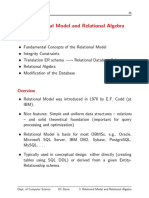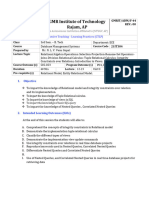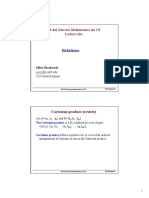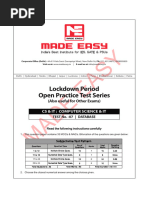Relational Algebra I
Relational Algebra I
Uploaded by
shahzaibali39390Copyright:
Available Formats
Relational Algebra I
Relational Algebra I
Uploaded by
shahzaibali39390Copyright
Available Formats
Share this document
Did you find this document useful?
Is this content inappropriate?
Copyright:
Available Formats
Relational Algebra I
Relational Algebra I
Uploaded by
shahzaibali39390Copyright:
Available Formats
ECS-165A WQ’11 43
3.2 Relational Algebra
Query Languages
• A query language (QL) is a language that allows users to
manipulate and retrieve data from a database.
• The relational model supports simple, powerful QLs (having
strong formal foundation based on logics, allow for much
optimization)
• Query Language != Programming Language
– QLs are not expected to be Turing-complete, not intended
to be used for complex applications/computations
– QLs support easy access to large data sets
• Categories of QLs: procedural versus declarative
• Two (mathematical) query languages form the basis for “real”
languages (e.g., SQL) and for implementation
– Relational Algebra: procedural, very useful for representing
query execution plans, and query optimization techniques.
– Relational Calculus: declarative, logic based language
• Understanding algebra (and calculus) is the key to
understanding SQL, query processing and optimization.
Dept. of Computer Science UC Davis 3. Relational Model and Relational Algebra
ECS-165A WQ’11 44
Relational Algebra
• Procedural language
• Queries in relational algebra are applied to relation instances,
result of a query is again a relation instance
• Six basic operators in relational algebra:
select σ selects a subset of tuples from reln
project π deletes unwanted columns from reln
Cartesian Product × allows to combine two relations
Set-difference − tuples in reln. 1, but not in reln. 2
Union ∪ tuples in reln 1 plus tuples in reln 2
Rename ρ renames attribute(s) and relation
• The operators take one or two relations as input and give a
new relation as a result (relational algebra is “closed”).
Dept. of Computer Science UC Davis 3. Relational Model and Relational Algebra
ECS-165A WQ’11 45
Select Operation
• Notation: σP (r)
Defined as
σP (r) := {t | t ∈ r and P (t)}
where
– r is a relation (name),
– P is a formula in propositional calculus, composed of
conditions of the form
<attribute> = <attribute> or <constant>
Instead of “=” any other comparison predicate is allowed
(6=, <, > etc).
Conditions can be composed through ∧ (and), ∨ (or), ¬ (not)
• Example: given the relation r
A B C D
α α 1 7
α β 5 7
β β 12 3
β β 23 10
σA=B∧D>5(r)
A B C D
α α 1 7
β β 23 10
Dept. of Computer Science UC Davis 3. Relational Model and Relational Algebra
ECS-165A WQ’11 46
Project Operation
• Notation: πA1,A2,...,Ak (r)
where A1, . . . , Ak are attribute names and
r is a relation (name).
• The result of the projection operation is defined as the relation
that has k columns obtained by erasing all columns from r
that are not listed.
• Duplicate rows are removed from result because relations are
sets.
• Example: given the relations r
r πA,C (r)
A B C A C
α 10 2 α 2
α 20 2 β 2
β 30 2 β 4
β 40 4
Dept. of Computer Science UC Davis 3. Relational Model and Relational Algebra
ECS-165A WQ’11 47
Cartesian Product
• Notation: r × s where both r and s are relations
Defined as r × s := {tq | t ∈ r and q ∈ s}
• Assume that attributes of r(R) and s(S) are disjoint, i.e.,
R ∩ S = ∅.
If attributes of r(R) and s(S) are not disjoint, then the
rename operation must be applied first.
• Example: relations r, s:
r s
A B C D E
α 1 α 10 +
β 2 β 10 +
β 20 −
γ 10 −
r×s
A B C D E
α 1 α 10 +
α 1 β 10 +
α 1 β 20 −
α 1 γ 10 −
β 2 α 10 +
β 2 β 10 +
β 2 β 20 −
β 2 γ 10 −
Dept. of Computer Science UC Davis 3. Relational Model and Relational Algebra
ECS-165A WQ’11 48
Union Operator
• Notation: r ∪ s where both r and s are relations
Defined as r ∪ s := {t | t ∈ r or t ∈ s}
• For r ∪ s to be applicable,
1. r, s must have the same number of attributes
2. Attribute domains must be compatible (e.g., 3rd column
of r has a data type matching the data type of the 3rd
column of s)
• Example: given the relations r and s
r s
A B A B
α 1 α 2
α 2 β 3
β 1
r∪s
A B
α 1
α 2
β 1
β 3
Dept. of Computer Science UC Davis 3. Relational Model and Relational Algebra
ECS-165A WQ’11 49
Set Difference Operator
• Notation: r − s where both r and s are relations
Defined as r − s := {t | t ∈ r and t 6∈ s}
• For r − s to be applicable,
1. r and s must have the same arity
2. Attribute domains must be compatible
• Example: given the relations r and s
r s
A B A B
α 1 α 2
α 2 β 3
β 1
r−s
A B
α 1
β 1
Dept. of Computer Science UC Davis 3. Relational Model and Relational Algebra
ECS-165A WQ’11 50
Rename Operation
• Allows to name and therefore to refer to the result of relational
algebra expression.
• Allows to refer to a relation by more than one name (e.g., if the
same relation is used twice in a relational algebra expression).
• Example:
ρx(E)
returns the relational algebra expression E under the name x
If a relational algebra expression E (which is a relation) has
the arity k, then
ρx(A1,A2,...,Ak )(E)
returns the expression E under the name x, and with the
attribute names A1, A2, . . . , Ak .
Dept. of Computer Science UC Davis 3. Relational Model and Relational Algebra
ECS-165A WQ’11 51
Composition of Operations
• It is possible to build relational algebra expressions using
multiple operators similar to the use of arithmetic operators
(nesting of operators)
• Example: σA=C (r × s)
r×s
A B C D E
α 1 α 10 +
α 1 β 10 +
α 1 β 20 −
α 1 γ 10 −
β 2 α 10 +
β 2 β 10 +
β 2 β 20 −
β 2 γ 10 −
σA=C (r × s)
A B C D E
α 1 α 10 +
β 2 β 10 +
β 2 β 20 −
Dept. of Computer Science UC Davis 3. Relational Model and Relational Algebra
You might also like
- Course - DBMS: Course Instructor Dr. K. Subrahmanyam Department of CSEDocument58 pagesCourse - DBMS: Course Instructor Dr. K. Subrahmanyam Department of CSEAvinash Alla100% (1)
- Relational Algbra IIDocument7 pagesRelational Algbra IIshahzaibali39390No ratings yet
- Unit III Relational Algebra and Relational CalculusDocument74 pagesUnit III Relational Algebra and Relational CalculusNivedita TuladharNo ratings yet
- FALLSEM2023 24 - BCSE302L - TH - VL2023240100776 - 2023 06 09 - Reference Material I 2Document49 pagesFALLSEM2023 24 - BCSE302L - TH - VL2023240100776 - 2023 06 09 - Reference Material I 2Suryadevara Meghana Chakravarthi 21BCB0125No ratings yet
- DBMS Unit 3Document93 pagesDBMS Unit 3vaishinikgNo ratings yet
- CSC311: Database Systems Chap 3: Relational Model: Lecture ContentsDocument56 pagesCSC311: Database Systems Chap 3: Relational Model: Lecture ContentsMd. Rashedul Islam 1511108042No ratings yet
- Unit III Relational Model 2Document31 pagesUnit III Relational Model 2bisol27639No ratings yet
- Relations and FunctionsDocument35 pagesRelations and Functionsnastaranesmaeilzadeh2No ratings yet
- Lecture 2Document82 pagesLecture 2Blahhh1No ratings yet
- DBMS ASSIGNMENT For PRACTICEDocument10 pagesDBMS ASSIGNMENT For PRACTICERitesh VermaNo ratings yet
- Relational AlgebraDocument58 pagesRelational Algebravaibhav singhNo ratings yet
- Relational Model Dan Relational AlgebraDocument32 pagesRelational Model Dan Relational AlgebraRebecca RekanitaNo ratings yet
- Database Systems - Lecture 7Document8 pagesDatabase Systems - Lecture 7Meregulwa AllanNo ratings yet
- Relational Calculus: We Will Occasionally Use This Arrow Notation Unless There Is Danger of No ConfusionDocument29 pagesRelational Calculus: We Will Occasionally Use This Arrow Notation Unless There Is Danger of No ConfusiondnlkabaNo ratings yet
- Relational AlgebraDocument34 pagesRelational Algebrasuraj joshiNo ratings yet
- Relational Algebra in DBMSDocument21 pagesRelational Algebra in DBMSSaurav SumanNo ratings yet
- Relational Algebra: Muhammad QasimDocument16 pagesRelational Algebra: Muhammad QasimSyeda Areeba RashidNo ratings yet
- Queries and Query Languages: Passive. That Is, They Do Not Modify TheDocument27 pagesQueries and Query Languages: Passive. That Is, They Do Not Modify TheMoses KabeteNo ratings yet
- Chapter 2: Intro To Relational ModelDocument39 pagesChapter 2: Intro To Relational ModelArey EntraNo ratings yet
- Relational Algebra-2023Document51 pagesRelational Algebra-2023張育安No ratings yet
- Relational AlgebraDocument37 pagesRelational Algebraarnabsantra0% (1)
- Unit-2 CH IIDocument58 pagesUnit-2 CH IIkaartheeka01No ratings yet
- Database Design, Implementation, and Validation: Vijay Kumar SICE, Computer Networking University of Missouri-Kansas CityDocument8 pagesDatabase Design, Implementation, and Validation: Vijay Kumar SICE, Computer Networking University of Missouri-Kansas Citybaluchandrashekar2008No ratings yet
- RelationDocument34 pagesRelationNarinder SinghNo ratings yet
- Relational AlgebraDocument17 pagesRelational AlgebraInderjeet BalNo ratings yet
- Lecture 7-9 (R.A)Document31 pagesLecture 7-9 (R.A)Huzaifa MemonNo ratings yet
- Rational Algebra 2Document47 pagesRational Algebra 2Maral FreijeNo ratings yet
- Database Management System: by Hemant TulsaniDocument67 pagesDatabase Management System: by Hemant TulsaniHemant TulsaniNo ratings yet
- TO Relational AlgebraDocument28 pagesTO Relational AlgebraChu Mạnh TuấnNo ratings yet
- Relations and Functions: Mathematics Concepts For ComputingDocument41 pagesRelations and Functions: Mathematics Concepts For ComputingvlnNo ratings yet
- Mis 301 Relational Database Management System 6&7Document10 pagesMis 301 Relational Database Management System 6&7Krishna RoyNo ratings yet
- DBMS Unit 2 Notes FullDocument40 pagesDBMS Unit 2 Notes FullSai KumarNo ratings yet
- R AlgebraDocument30 pagesR AlgebraSamuel RajuNo ratings yet
- DBMS3Document91 pagesDBMS3parthdarjiasiNo ratings yet
- CH - 4 Fundamentals of A Database SystemDocument8 pagesCH - 4 Fundamentals of A Database Systemblackhat0917No ratings yet
- AlgebraDocument36 pagesAlgebraamanantonyNo ratings yet
- Mathematics 2019-2020 Scheme of Work/term Wise Syllabus Breakup Class 10Document4 pagesMathematics 2019-2020 Scheme of Work/term Wise Syllabus Breakup Class 10Stella ElytraNo ratings yet
- 2009 Ssde CCSDocument56 pages2009 Ssde CCSlatebmelissaNo ratings yet
- 4 RelationalAlgebraDocument108 pages4 RelationalAlgebraarun vilwanathanNo ratings yet
- DBMS Unit 2Document30 pagesDBMS Unit 2mimipe8643No ratings yet
- Relational AlgebraDocument53 pagesRelational Algebrabeauty within usNo ratings yet
- Relations and FunctionsDocument37 pagesRelations and FunctionsManish ThakuriNo ratings yet
- 2 Relational Model Part 1of3Document24 pages2 Relational Model Part 1of3co22352No ratings yet
- Divsion - Slides - Relational AlgebraDocument6 pagesDivsion - Slides - Relational AlgebraJazibSawarNo ratings yet
- Lec # 15,16 - Relational AlgebraDocument35 pagesLec # 15,16 - Relational AlgebraAbdul MaroofNo ratings yet
- 08 Relational AlgebraDocument34 pages08 Relational AlgebraMANI 96 FFNo ratings yet
- 1.2. Relational ModelDocument22 pages1.2. Relational ModelragulNo ratings yet
- Database 04 Relational Algebra Part1Document17 pagesDatabase 04 Relational Algebra Part1Rasd sdaNo ratings yet
- Lecture7 Rel-AlgDocument36 pagesLecture7 Rel-Algmaxohm24No ratings yet
- Relations: CS 441 Discrete Mathematics For CS Lecture 21bDocument11 pagesRelations: CS 441 Discrete Mathematics For CS Lecture 21bbharathNo ratings yet
- Class 9 Relational AlgebraDocument48 pagesClass 9 Relational AlgebraVijay PrimeNo ratings yet
- Lecture 03 Relational ALgebra and Relational CalculusDocument45 pagesLecture 03 Relational ALgebra and Relational CalculusTrịnh Thái TuấnNo ratings yet
- 5eigenvalues and Eigenvectors #5Document32 pages5eigenvalues and Eigenvectors #5Sparky VSNo ratings yet
- DBMSDocument5 pagesDBMSAbdulRahman WaseemNo ratings yet
- Test 7 CS Databases PDFDocument19 pagesTest 7 CS Databases PDFPALLAVINo ratings yet
- Chapter 3: Formal Relational Query LanguagesDocument51 pagesChapter 3: Formal Relational Query LanguagesHưng PhạmNo ratings yet
- Relational Algebra - 6Document15 pagesRelational Algebra - 6syed hamzaNo ratings yet
- Chapter 6 Relational AlgebraDocument29 pagesChapter 6 Relational Algebragemechubonsa029No ratings yet
- Zend PHP Certification Study guide Zend Technologies 2024 scribd downloadDocument85 pagesZend PHP Certification Study guide Zend Technologies 2024 scribd downloadhaksofamoza100% (4)
- LRN3322_In-Memory_10_Year_Anniversary V3_1724971329244001ReszDocument76 pagesLRN3322_In-Memory_10_Year_Anniversary V3_1724971329244001Reszddqcwk2cpnNo ratings yet
- DBMS Practical FileDocument94 pagesDBMS Practical FileHeman SetiaNo ratings yet
- CS8492 DBMS Unit 1Document22 pagesCS8492 DBMS Unit 1Grace Shalini T CSE1754100% (1)
- TensorFlow For Machine IntelligenceDocument306 pagesTensorFlow For Machine Intelligenceneeraj12121No ratings yet
- Python Cheat Sheet For BeginnersDocument26 pagesPython Cheat Sheet For Beginnersabhilash gowdaNo ratings yet
- Dependency Analysis enDocument18 pagesDependency Analysis enwegeneargow11No ratings yet
- Bottom Up Parsing - Compiler Design - Dr. D. P. Sharma - NIT Surathkal by Wahid311Document53 pagesBottom Up Parsing - Compiler Design - Dr. D. P. Sharma - NIT Surathkal by Wahid311Abdul Wahid KhanNo ratings yet
- Template IJOBAS2022Document3 pagesTemplate IJOBAS2022Ulfa Andini DianNo ratings yet
- HTML CSS Notes TronixDocument114 pagesHTML CSS Notes TronixsathipandunulakaniNo ratings yet
- Curriculum Till DE-39 PDFDocument173 pagesCurriculum Till DE-39 PDFubaid umarNo ratings yet
- Chapter 1 (Reviewer)Document3 pagesChapter 1 (Reviewer)Bridget Nicole BordeosNo ratings yet
- Database Management System: 5 & 4 Semester IT & CSE Session: 2017-2021, 2018-2022Document10 pagesDatabase Management System: 5 & 4 Semester IT & CSE Session: 2017-2021, 2018-2022kevin felix caluagNo ratings yet
- De Luna - Activity 3Document3 pagesDe Luna - Activity 3Mark Joseph De LunaNo ratings yet
- Introduction To Datascience (R20DS501)Document162 pagesIntroduction To Datascience (R20DS501)kenNo ratings yet
- Programming Assignment CSD (Batch 14)Document4 pagesProgramming Assignment CSD (Batch 14)Mohamed AtheebNo ratings yet
- Ai Unit-2Document45 pagesAi Unit-2AnjaliNo ratings yet
- Ch.7 INtroduction to Python Question Answers 2023_24Document8 pagesCh.7 INtroduction to Python Question Answers 2023_24arshj3859No ratings yet
- XII CS practical (1-17)Session 2024-25Document46 pagesXII CS practical (1-17)Session 2024-25vaisakhsn52No ratings yet
- EAI3Document162 pagesEAI3bhargav56No ratings yet
- SQL AssignmentsDocument3 pagesSQL AssignmentsalivaNo ratings yet
- VlogDocument14 pagesVlogUday KumarNo ratings yet
- 5-Axis-Machining Centers: Highpower-Series Moving Coloumns-Reihe Highspeed-SeriesDocument16 pages5-Axis-Machining Centers: Highpower-Series Moving Coloumns-Reihe Highspeed-SeriesSuraj SheteNo ratings yet
- ChangesDocument44 pagesChangesMyra López AndradeNo ratings yet
- Chap 10Document26 pagesChap 10Durba Binte KalamNo ratings yet
- SQL - Level 1Document12 pagesSQL - Level 1weirdwolfvortexNo ratings yet
- Exception Handling JavaDocument21 pagesException Handling JavaSaptadip SahaNo ratings yet
- C Practical FileDocument69 pagesC Practical FileSukhveer Sanghera100% (1)
- Hacking - 201204Document75 pagesHacking - 201204Danilo CarusoNo ratings yet
- C Programming With AlgorithmsDocument33 pagesC Programming With AlgorithmsD.Joshnavi RamyaNo ratings yet

























































































